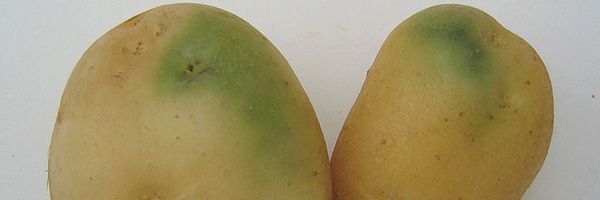
Greening
Tuber greening would only be a minor cosmetic problem if it did not reveal the presence of an abnormal quantity of alkaloids (glycoalkaloids, mainly solanine and chaconine), substances which impair the flavour (causing bitterness) and could be toxic for the consumer (above 200 mg per kilo of fresh weight). There is no direct relation, however, between chlorophyll content and alkaloid content in greened tubers.
- Symptoms
Originating from the stolon, the tuber has all the characteristics of a stem, including the ability to produce chlorophyll under the effect of light and thus becoming green.
Greening does not occur if the tuber develops in the soil but can happen if exposed to light during growth or storage. Crop greening on superficial tubers (photo 1) is usually more intense than diffuse post-harvest greening (photo 2).
The pigment is synthetised essentially in the first three millimetres of tissues situated on the periphery of the tuber.
- Risk factors
Potato cultivars have different levels of susceptibility to greening.
Generally speaking, any factor that affects tuber maturity (excessive nitrogen supply, early haulm destruction, etc.) results in a higher than normal alkaloid content at harvest time. Moreover, tubers harvested prematurely (early potatoes) are highly susceptible to greening when exposed to the light.
This susceptibility gradually diminishes during maturation, but mature tubers are also prone to greening just after harvesting, whereas after several months in storage their susceptibility is substantially reduced.
The increase in the tuber’s chlorophyll and alkaloid content is proportional to the increase in light intensity and the hours of light to which it has been exposed.
- Control measures
Prevention begins during cultivation with a few essential rules:
- prepare the soil in such a way as to avoid the formation of clods and adapt the depth of tillage according to the type of soil;
- ensure a spacing of 90 cm between rows and adjust planting depth according to the cultivar;
- prepare wide ridges with good quality soil, keeping the seed tubers in the centre of the ridge;
- irrigate in order to prevent ridge destruction and the formation of cracks;
- if necessary, fill in the cracks in the soil by “rolling”, after haulm destruction.
During harvesting, storage and packing, the potato tubers should only be exposed to daylight for the time required for handling and the exposure to direct sunlight should be minimised.





